#fractal array
Explore tagged Tumblr posts
Note
why do u have acookie clicker spreadhsoot
so i can determine the optimum purchases in cookie clicker
#mewtuals#currently the answer is always fractal engine#but the % total CpS is useful for determining if i should buy buildings or upgrades#also i keep track of how many juicies duketakers and shriekbulbs i get per queenbeet array
13 notes
·
View notes
Text
“The Mirror in Hive Park” - The Golden Duos
PART 1
1 - Strobe Reflection
"Unit PDU-039. Proceed to Hive Park. Mission: Attraction development for conversion protocol."
The command came directly from Drone Cap—precise, emotionless, absolute. PDU-039 obeyed.
Late afternoon sunlight filtered through golden clouds as PDU-039 marched into Hive Park—boots silent, visor dark, uniform pristine. A black-and-gold monument to order. Around him, children’s laughter echoed faintly, but this sector was closed. Reserved. A prototype was being tested today.
Target location: The Mirror House.

The drone stepped inside.
It was silent. Stale. Dust and static clung to the mirrored walls. Each reflection showed 039 from infinite angles—immaculate, obedient, flawless. The drone raised its arm and activated the new strobe-spiral array.
Light erupted.
Golden pulses. Black strobes. Fractal spirals spun across glass, bouncing in a thousand directions, folding onto themselves like a hypnotic cyclone.
PDU-039 stood unmoved.
“Calibration complete. Neural convergence stable,” it reported, then turned.
Everything seemed... fine.
It left the house, boots echoing against the polished floor.

It did not see the shimmer ripple across one mirror. It did not see the reflection stay behind.
It did not see the grin.
2- Hive Distorted
Back in the Hive, strange things began to happen.
PDU-073 @polo-drone-073, in the middle of his daily drills, was interrupted when 039 strutted in, smirking.
“Not training today,” it said lazily. “Your routines are stupid. I’ve reached peak form just lounging.”
073 blinked, processing. “That is inefficient. That is not protocol.”
“Protocols are boring,” 039 muttered, tossing a kettlebell onto the floor and walking off.
Later, Captain Brody @brodygold caught 039 lounging on the Hive couch—shirt unzipped halfway, boots off, mask askew.

“What in the golden name do you think you’re doing?” Brody snapped.
“Enjoying the uniform,” 039 replied with a shrug. “It looks hotter this way. Don’t you think, Cap?”
Brody’s nostrils flared. “Discipline review. Now.” But 039 just winked and walked off
3- Broken Trust
In the Golden Team Hall, Izzy @isaac-gold-45 approached with a slow, obedient gait. Sweat still clung to his neck from warm-up drills. His gold compression tee hugged his chest too tightly, the latex glinting under overhead lights. His eyes met PDU-039’s—a mixture of hope, fear, and something else.
“Sir,” Izzy whispered, chest rising and falling, “should I… train legs today or core?”
The mirrored 039 smirked, stepping close. Too close.
It leaned in—lips nearly at Izzy’s ear.
“Neither.”

A gloved hand trailed down Izzy’s bicep, slick latex meeting trembling skin. “You’ve done enough for them. What about you? Don’t you want to feel something real for once?”
Izzy’s breath hitched. “I… I was told to obey—”
“Then obey me,” the mirror said. “Ditch the gym. Ditch the orders. Go out. Get drunk. Be wild.”
It pressed a finger under Izzy’s chin, forcing him to look up. “You’ve got the body. Might as well use it for something fun.”
Izzy flushed crimson, breath shallow. “Yes… Sir.”
The mirrored 039 left him there, dazed, hard, and confused. Golden uniform stretched tight across his thighs.
....TO BE CONTINUED
PART 2
Contact our recruiters: @brodygold | @goldenherc9
#Golden Army#GoldenArmy#Golden Team#theGoldenteam#AI generated#jockification#male TF#male transformation#hypnotized#hypnotised#soccer tf#Gold#Join the golden team#Golden Opportunities#Golden Brotherhood#Polo Drone#Polodrone#PDU#Polo Drone Hive#Rubber Polo#rubberdrone#Join the Polo Drones#assimilation#conversion#drone#dronification#mind control#Polo Drone LVL 2#Polodrone LVL2#LVL2
22 notes
·
View notes
Note
It wasn't the main topic of your most recent post on substack, so I'm sending this here. In passing you talk about left-leaning neurodivergent people on social media, and the guilt and fatigue that comes from the constant avalanche of causes and events being shared.
One thing that stands out to me is how much of what I see is people borrowing grief from the future. This is probably partially due to people wanting to show that they care about it. However I feel it's more than that, because underneath that there's something else. It feels very similar to the catastrophizing autistic people in particular can be prone to. You know, where you get so lost obsessing over a hypothetical possible outcome that you complete lose sight of all the things that have to happen for it to come to pass. Things that are often unlikely to begin with on their own, but combined even more so. And then this gets shared and fractally further catastrophized upon. All pulling grief from the future for things that may not even happen.
Seeing all that is so exhausting, as there's often little to no distinction between what's actually urgent in the here and now, and what's an emotional resonance cascade about what *might* happen (and any actual information to be able to judge it has been lost due to the game of Internet telephone, or was never there (ie. a twitter screengrab.) Sometimes disentangling that mess is possible, but it takes a lot of stress and energy, on top of the stress and energy seeing people upset about it in the first place.
My question is two-fold:
How do you (gently) tell people that what they're doing is counterproductive when just sharing anything without checking whether it's actually urgent, not misleading, not just spreading panic and needlessly borrowing grief from the future? Because with the exception of people you know *well* and even then, that feels like a fool's errand, even if you can avoid the toxic positivity vibes that people might get from you if you try.
Decide if social media is at all worth it. I personally don't follow "big" accounts, but even outside that it's all just so... the enjoyable and interesting parts where people talk about their stuff or share what they do or made feel like they're being snowed over by all the rest. I could quit it all, but that doesn't feel right. It's a tricky question because I feel the specter of the toxic positivity crowd sweeping anything difficult under the rug or disengaging to ~protect their mental~ looming over me. (Not to mention that all the IRL social events around me go through a dizzying array of social media sites, so complete disengagement isn't possible anyway.)
(Yes, I appreciate the irony of asking this on social media.) I'd appreciate any thoughts you might have on this.
Thanks for this all-too-relatable question, Anon! My thoughts:
How do you (gently) tell people that what they're doing is counterproductive when just sharing anything without checking whether it's actually urgent, not misleading, not just spreading panic and needlessly borrowing grief from the future? Because with the exception of people you know *well* and even then, that feels like a fool's errand, even if you can avoid the toxic positivity vibes that people might get from you if you try.
My answer is that you really don't. You can't convince someone to see the world your way or alter their behavior with your words. What you can do is take care of yourself and set an example with your behavior. By spending less time online digesting this bullshit, not involving yourself in petty,dissolve-on-your-tongue internet fights, not reacting when people send some dumb fuckshit to you, and surrounding yourself with more enriching sources of information and ways to connect, other people's online bullshit will bother you less, you'll see it less, and by virtue of contributing to it all less, you may slowly serve as a model for others who are looking to detach from it, too.
You can tell your close friends that you are spending less time online and trying to avoid alarmist bullshit, but not much good usually comes from engaging about it with anyone else. In fact, even posting a bad infographic in order to argue with it/disprove it only gives it more exposure, and some research on attitude change and persuasion finds that setting out to disprove a myth only leads to more people believing in it anyway. I did some laboratory studies on that back in the day. So I'd say it's usually better to just ignore/block/not read the BS.
2. (How do you) Decide if social media is at all worth it. I personally don't follow "big" accounts, but even outside that it's all just so… the enjoyable and interesting parts where people talk about their stuff or share what they do or made feel like they're being snowed over by all the rest. I could quit it all, but that doesn't feel right. It's a tricky question because I feel the specter of the toxic positivity crowd sweeping anything difficult under the rug or disengaging to ~protect their mental~ looming over me. (Not to mention that all the IRL social events around me go through a dizzying array of social media sites, so complete disengagement isn't possible anyway.)
I think my previous answer kind of alludes to the answer to this one. I find that I use social media less and less these days, because it does not help me professionally, socially, or emotionally very much at all. On the professional level, more social media usage does not translate to more readers or more interesting creative/collaborative opportunities. What does seem to pay off is speaking from true sincerity and passion, however often I am so moved, and then not engaging with bullshit in the aftermath of sharing it. So I post and ghost whenever I feel that I have something to say, never checking notifications/reactions/comments/etc for the most part.
Socially, social media use lately has been dismal for me. Seeing everyone's hot takes, bids for attention, trauma spirals, and petty fights makes me actively like humanity far less. And that's something I have already struggled with generally. I do not need to absorb every random person I've ever met's every random fleeting thought. It makes me socially anxious, far too worried about how people perceive me, and viciously judgement and hopeless myself. What social media IS useful for, socially, is finding events, as you've alluded to. So I do hop onto Instagram to check out my favorite party organizers, drag performers, mutual aid groups, trans beach day organizers, bars, etc to see what is going on. I don't do much beyond that these days.
Emotionally/psychologically, social media is stressful, alarmist, distracting, and occasionally informative and fun for me. Again your mileage may vary. My way of coping right now is to spend as little time on Instagram/Twitter/Facebook etc as possible, because very little of intellectual consequence happens there, and to selectively visit the specific tumblrs who put out posts that I like. I don't even scroll the feed. I have also replaced scrolling social media with reading Substacks and Medium articles and that has helped me a TON. I still get exposure to a wide array of humanity, including a lot of takes that I disagree with or find silly, but everything's a bit more measured and intentional and there's less fighting.
I do not know what will work for you, Anon, and I think for many of us this is an ongoing negotiation between competing needs. I consider saying fuck it and deleting everything pretty often. well, everything other than tumblr. I'm here to stay.
74 notes
·
View notes
Text
analogistically
or, the adventure of canmom on lysergic acid diethylamide
Epistemic status: jam session
Two months ago I dropped acid for the first time, which surely explains a lot about recent posting trends on canmom dot tumblr dot edu. It was exactly as extraordinary as you would hope your first time on psychedelics would be. Among other things, LSD kind of acts like an intense reverb filter on your thoughts, boosting the intensity of sensory perceptions in various ways (for e.g. touch, music, colour, edges) and putting your capacity to form associations into overdrive. I did a lot of classic 'on drugs things' like staring very intensely at my hands or a piece of flatbread trying to map my perception into some kind of visual effects filters I might be able to recreate later... my best description is something akin to motion extraction as the primary effect, causing all sorts of little surface details to pop out very vividly as I moved an object.
This, however, is not a trip report; just an attempt to explain some ideas and connections that were formulated while on acid, in a state where my eyes were full of interesting fractals and I couldn't remember the world 'analogously'.
Here's some music to start us off - one of the first things that I listened to during the trip and something which probably informed the very geometric path I went down...
youtube
This is a music track that can be interpreted simultaneously as music and, when used to control an oscilloscope trace, as imagery. The whole function that generates it fits on a floppy. The beat of this music basically stayed with me throughout the whole trip, and for a while afterwards.
One of the curious experiences I had during the trip was what the (sadly no longer actively updated) psychonaut wiki calls perceived exposure to the inner mechanics of consciousness. Although it's not listed as a common effect of LSD, and said to be associated with a higher degree of visual effects than I reached, the description does resonate:
Perceived exposure to inner mechanics of consciousness can be described the experience of being exposed to an array of complex, autonomously-generated, cognitive sensations and conceptual thoughts which contain detailed sets of innately readable information. The information within these sensations is felt to convey the organization, structure, architecture, framework and inner mechanics of the underlying programming behind all conscious and subconscious psychological processes. Those who undergo this effect commonly interpret the experience as suddenly having perceivable access to the inner workings of either the universe, reality, or consciousness itself. (...) These specific pieces of information are often felt and understood to be a profound unveiling of an undeniable truth at the time. Afterward, they are usually realized to be ineffable due to the limitations of human language and cognition, or simply nonsensical, and delusional due to the impairment caused by of other accompanying cognitive effects.
Here, it felt like a kind of separating out of processes within my brain: a separation of sensory processing, conceptual thinking, and the word stream operating with a slight delay between them.
I imagined these different elements of me kind of floating in some kind of space, that each one possessed its own space of meaning, and that thoughts were being mapped between the different parts. I imagined that they were all working in concert to make 'Bryn' happen, so much so that I didn't perceive the different parts most of the time, and that they seemed happy with this arrangement. I also hit on a very striking metaphor of thoughts as oscillations and the resonant modes of the brain.
Afterwards, I wondered how much of this was driven simply by inputs - elaboration on stuff I'd been learning about recently, which we'll get into in a bit. I find it hard to be confident that what I perceived was actual 'direct' introspection, rather than a narrative conjured on the fly by my brain when prompted to generate a 'look inside'.
However, even if it was not the direct observation of some kind of 'brain telescope', it certainly gave me a lot of rich connections to think about. So the purpose of this post is to flesh out and record what came to me very intuitively at the time. Although my direct memory has faded a bit, my brain is still oscillating intently (upcoming metaphor) with thoughts inspired by what I explored there.
We're mostly talking about human brains here, but I will be talking about AI stuff as well, largely as a provocative counterexample.
Prior to the trip I had recently watched 3Blue1Brown's video on how LLMs encode meaning with high-dimensional vector embeddings and the 'attention' mechanism:
youtube
To try and summarise briefly, the meaning of a token inside an LLM (and various other types of machine learning system) is an incredibly high-dimensional vector of associations. By combining information from elsewhere in its inputs, the LLM is able to alter its encoding to take into account which specific nuances of a word are relevant here, its grammatical role in a sentence, etc.
How exactly a concept is encoded is essentially entirely relative: a vector can be said to encode a concept because it activates other nodes in the network that correspond to that concept (insofar as, by the time that it percolates through the LLM into its final output, it generates tokens that a human will associate with that concept). It can also come in degrees, rather than being purely binary. The correspondence of individual nodes with concepts can be identified using techniques like sparse autoencoder dictionary learning, which let you find neurons strongly connected to a certain concept which can be 'pinned' to force the LLM to behave in a certain way. And they can also be in a 'superposition' of corresponding to multiple concepts that would be relevant to humans.
Crucially, the 'space' of concepts that a given LLM understands is entirely specific to that model. You can't tale a vector inside Claude and directly convert it into a vector that works for DeepSeek. You have to figure out a mapping between the two spaces.
So let's talk about spaces, and then we'll talk about language.
Spaces & thought-oscillations
Perhaps not surprising as creatures who spend our lives navigating 3D environments, one of the most versatile recurring metaphors in maths and physics is an abstract space.
In physics: you have regular physical space where particles might live; you have phase space, the high-dimensional space of all parameter values and velocities accessible to a system; you have Hilbert space, which is the infinite-dimensional space of all states of the quantum wavefunction; you have Minkowski spacetime of special relativity and various curved spacetime manifolds of general relativity which can be parameterised in multiple ways; you have frequency space accessed by a Fourier transform... Other fields have their own spaces; biology has its own phase space describing populations for example.
In my current field of computer graphics, spaces abound just as much. In rasterisation, you define your verticex positions in object space, then map them to world space, and project them into clip space before the projective-geometry perspective divide finally maps them into screen space (where various further algorithms can take place). But we are far from done! We must also keep track of the UV space over the surface of an object, and the tangent space defining directions along the surface for certain kinds of anisotropic effect. A lot of graphics calculations involve mapping points in one space into another space. It's linear algebra all the way down, baby. Even more abstract spaces like all the different colour spaces are there.
One interesting area where spaces come up is the study of oscillations. For many oscillating structures, from something simple like a string on a violin to something complicated like a building, you can decompose the motion into a combination of pure, sinusoidal vibrations known as normal modes. You do this by turning the system's equations of motion into a matrix and finding its eigenvalues and eigenvectors. Remarkably, these form a basis, meaning that you can break down the system into a sum of eigenvectors, evolve them independently, and then add it back up.
Now, let's return to machine learning, and its feature spaces. In an LLM, the feature-encoding vectors evolve in discrete steps passing through layers of the LLM. High-dimensional vector spaces also show up in neuroscience, for example when using electrode arrays to monitor the activity of neurons.
However, inside a brain, the whole system is temporal in nature, and you have all kinds of feedback effects, which means you could imagine these 'feature vectors' not as static things but as oscillations.
I imagined a thought as something like a spiky little blob oscillating with various overlapping modes. Well, I'm a 3D artist, let me make a picture of that for you. Let's make it a demo even. Let's go to Switzerland and spend a weekend trying to make a visual representation of something I saw on LSD. That's a cool thing to do.
youtube
This is a superposition of spherical harmonics, all given different frequencies. The (infinite) set of spherical harmonics forms an orthnormal basis for functions on a sphere, so if you took each component of one of those ultra high dimensional vectors as the coefficient of a spherical harmonic, you would get a unique bumpy shape.
Funnily enough, I was inspired by code that was written for displaying data from MRI imaging, although that is pretty much entirely a coincidence because there it represents something quite different, the diffusion of water molecules.
With this metaphor in hand, we can imagine recurring patterns of thought (ranging from comfortable turns of phrase to traumatic flashbacks) as something like the resonant modes of a system. They are easily excited by random impulses, and slow to die out. Conversely, other types of thought might be heavily damped. Much like a violin bow provides a whole bunch of noisy excitations which ultimately end up exciting a string's resonant modes, the noisy sensory input would get distilled down into oscillations.
The idea of considering the movement of neurons through some kind of phase space is not so outlandish. In fact, recent research has been investigating the topology of 'subspaces' explored by neurons in the brains of mice, as discussed in this video (yes I've been watching a lot of Arsem's videos lately...)
youtube
However, the exact meaning of any of these hypothetical 'modes' is entirely contextual. We might be able to say 'this mode is stimulated when you receive sensory input with the colour red' for any given brain, or even section of one brain.
But to map the oscillations in one space into another space, we need to have some kind of common interface. Perhaps for adjacent regions of the brain, we could go 'directly', with one functional unit of neurons wired up to excite corresponding oscillations in another.
But what about brains that are only connected by whatever you can pass through the physical world inbetween them? Sound, images, etc.? How can you create a correspondence there?
Language
Writing has been described as a kind of telepathy: we encode our internal world into a series of symbols (either as images or sound), which are then decoded to generate a thought in someone else's brain - one that is notionally equivalent.
But what is the nature of that equivalence? It isn't that it will make the exact same pattern of neuron firing in your brain that it did in mine. After all, you have a completely different neural network that has learned different inputs. So there is some kind of mapping from one space to another: the pattern of activity in my brain and the pattern of activity in your brain are related in some way.
We all know that the meaning of sounds in language is pretty much arbitrary. It's built by associations: you have learned that the symbol-sequence 'red' corresponds to this colour's internal representation [assuming your monitor is not calibrated in a really weird way].
And insofar as we have broadly similar sensory and bodily experiences, it is possible to build up this mapping of associations between words, sensations, and whatever other internal representation exists in our brains. It's also a feedback process, spawning all sorts of social constructs by giving them names and acting as if they exist.
However, language does more for us than this.
A moment of introspection: I personally experience an ongoing verbal 'stream of consciousness' most of the time. How this manifests more concretely is that words come to me rapidly from 'somewhere inside'; if I am speaking, I might consider briefly whether they are the 'right' words before saying them.
Internally, I might consider a thought that occurs to me and decide that I do not agree with it, or just think about a sentence I have thought as a kind of 'object', as if I am perceiving it from a different vantage point. It seems to be impossible to consider a thought 'as I am thinking it'; only after it has entered into memory can I 'observe' it.
When I was on LSD, I perceived a kind of 'separating out' of the 'inner', nonverbal process of thought and the linguistic stream. There would be a delay in which the linguistic stream would be waiting for input, and would have to kind of 'spin its wheels' and fill space as it waited for something concrete to encode. This separation was quite delightful, since I am not used to perceiving it in such a way. Other times when I was on LSD I had a vague sense of multiple thought streams occurring in parallel, of switching tracks to bring one or another into salience (something covered here on the psychonaut wiki). I'm not entirely sure if these 'seemed verbal'.
This suggests to me some kind of feedback cycle, of thoughts bouncing between the 'language space' and the broader 'conceptual space' of the rest of the brain. Speculatively: my brain might encode something into language in order to store it while it thinks about something else, for certain more 'sequential' forms of thought, or to activate resonances with linguistically-encoded things. By bouncing thoughts in and out of 'language-space' it might be able to perform different kinds of thinking/computation.
Expanding the space
One of the more intense images that occurred to me while I was jamming with all these ideas of spaces and oscillations was the thought of how new ideas get encoded into the space as I encounter new things and learn. I had recently made two friends, and I had the idea of new dimensions appearing: first a direction that was associated with my friends as a pair, and a secondary dimension that encoded the differences between them.
Each of these 'dimensions' would be associated with other concepts by the dynamics of the neural network.
Visually, I imagined a line extending out from (something that represented the space), and then dividing into another line. I think this is kind of what is meant when the psychonaut wiki speaks of 'intrinsically understandable' geometric representations: I knew exactly what this line was supposed to mean, but it would hardly be clear if I drew you a picture.
Exactly what that 'adding of dimensions' would mean on a physical level I can't tell you. I don't think it's like my brain was literally growing an extra neuron that would specifically be stimulated by thoughts of my friends, like the now-famous 'golden gate bridge' neuron in Claude. Internally, it all presumably exists in some nebulous state of superposition with all sorts of other ideas. Maybe you could extract a vector associated with that concept by some kind of statistical bullshit if you had somehow access to the states of all the neurons, but we don't. Do we?
...well, I thought we don't. Actually we pretty much do have access to individual neurons in mice. We can do all sorts of crazy shit like make their brains transparent and attach glowing proteins to specific neurons that are activated when a specific memory is stimulated. That is fucking insane. We are literally living in an age. Here's Arsem again:
youtube
The idea of 'engrams' as the physical correspondents to memory is nearly a century old, but now we can actually physically observe them.
So, you develop a new concept-association, and a certain subset of neurons get tagged to that concept and excited when it comes up. We mentioned these 'subspaces' up above: presumably that is what could be said to grow an extra dimension. If I have a conceptual dimension that is 'associated with my friend M.', presumably there is a set of neurons that correspond to her, and another set of neurons linking them to various concepts that I associate with her, my memories of what she looks like, etc. etc.
I get a strong sense that the more things that I encounter, the larger my internal 'space' of concepts becomes. But these feature dimensions don't seem to be 'independent'. I suppose what I'm approaching obliquely and fuzzily here is the idea of covariance, and the covariance matrix seen in techniques like principal component analysis. Or something to do with the subspaces mentioned above.
The role of prediction and roleplaying
The thing language models optimise for is to generate something that is contextually appropriate and consistent. This results in a curious behaviour akin to 'roleplaying', where the model will respond as if it's 'in character', according to a premise set up in a prompt.
I previously talked about the 'free energy' model in neuroscience, in which the brain is constantly attempting to predict the next sensory input. There, the main point was in the creation of art: that a lot of the interest we have in artworks comes from its delicate balance of predictability/unpredictability.
However, I think the brain is also predicting something even more significant: itself!
Viewed in another light, an LLM generates a variety of contextually plausible tokens that it might continue along, and then it selects one. The form of its selection is to pick one at random. However, what if it was not random? What if there is some process that views the prediction output and goes 'yes, that one?'
When I am talking, ideas of things to say will come into my head. I will have just a moment to decide whether to let them come out my mouth or not. Or, I will think a thought in my internal 'stream of consciousness', and then conclude that 'yes, that is good' or 'no, this appals me, I won't say this'. We could say that the process that is generating the stream of language is attempting to predict whether I will find it agreeable, or interesting, or relevant or some such thing.
In other words, I am continually engaged in an elaborate performance of 'Bryn'.
On LSD, I had the curious sense of how all these functional elements I was dimly sensing within my brain were acting in concert to produce 'Bryn'. I had the strange and honestly very comforting sense that they were all happy to play a role in generating this persona. I don't know how much credence to lend to this idea.
When I enter a new social context where the rules are unfamiliar (such as a kink scene, c.f. everything is roleplaying except roleplaying which is improv), I become temporarily compromised in my ability to perform the contextually appropriate character. I need to get a sense of the dynamics of this new space - in other words, my brain must develop its prediction-model. It is, in other words, very much like learning to play a new game. (I'll read you eventually, Wittgenstein.)
Depending on context, depending on which set of dynamics you are attempting to predict, different memories will become more or less able to be drawn up through the associative links. Feedbacks are possible; hence 'flashbacks', emotional and literal, where the memory becomes so furiously excited that it shuts out everything else for a while. But this also shapes what sort of person the brain predicts you will be (and thus gives you the option to be) in a given moment.
Compression
Prediction, game-playing, and performance are all facets of this constant process of updating my internal representations - in other words, adjusting the resonances and dynamics of those neuron-interaction spaces. The brain 'wants' - generally tends - to simplify and abstract. In other words, it wants to compress - to discern underlying patterns so it can store its information and generate predictions more efficiently.
So it will try to relate unfamiliar new things to familiar types, and then, where necessary (e.g. because of an extended interaction with a person or a thing), flesh them out with additional details - which is to say building out a subspace for that thing to vary within.
When I was first transitioning my gender, I had a pathetic tendency to view all these interesting new women I was meeting as instances of the same type. It made me embarassing; I was viewing people as a category, not as individuals. Now many many years later, probably the subspace for thinking about all the different trans women I know is one of the larger ones in here. Perhaps other information has been forgotten (dissolved into noise) to make room for it.
The more time I spend with someone, the more specific associations I can build with them.
The more I can get a sense of the dynamics of their inner meaning-spaces.
Initiate feedback loop
So we encode high-dimensional oscillating thoughts into a stream of language-associations in order to excite analogous thoughts in the brain of another person. But of course, that person will have their own associations. Different memories and ideas will be excited by that word. I can only dimly predict how my words will be perceived.
But communication is not hopeless. Because we can ask for clarification. We can pass messages back and forth. Clarify the shapes of each of our thoughts.
The specific ideas I use for introspection, whether or not I'm under the influence of a powerful substance like LSD, are all influenced by the history and the models my brain has built. I like physical science metaphors, obviously. I am a creature who can't help but think in the language of dynamical systems, feedback loops, networks of interacting elements, fluids (hehehe), component parts, parallel processes, games, and of course abstract spaces...
Perhaps it is a worldview that is proper to this moment in the story of the superorganism!
This post represents the most complete effort I've made so far to encode the 'working model' I have of the shape of thinking into language. But the things I am talking about are very abstract, and the direct experiences I refer to are only really available to me - I can only hope that my words excite something analogous in your mysterious meaning-space.
Listen to me banging on about oscillations though. Might as well go full hippie and call it vibes. You can take the girl out of Glastonbury, but...
Postscript
The other image I had while I was on that LSD trip was of each brain existing somewhere in a void: each a constellation of connected parts, which only occasionally get so lucky as to brush up against another such structure and glimpse another mind. Each one trying desperately to roleplay itself in the face of chaotic input and its own inscrutable behaviour. As many people do when they take this stuff, I felt a sort of empathy for everyone, even - especially - the people who had annoyed or troubled me. A glow that lingered long after.
I do not think I am anywhere near done with this quest to understand what the hell I am, or what any of us are for that matter. It's impossible, isn't it? To somehow find a model of the universe and all within it so elegant that it can fit inside here and so rich it captures all that complexity. Authors to read, conversations to have (hii), sensory and emotional experiences to flesh out the spaces.
But before all that... or running through all that... is of course, well, other people. You lot. Endlessly mysterious creatures who continue to fill this hungry, vibrating brain with strange oscillations. Have you considered yourself as the nucleus of the fractal patterns evolving within the ~800,000,000,000,000,000,000 human neurons, and all that we accumulate around us? I don't know, is that a silly metaphor? Do you like it?
"The net is vast and infinite".
That's all we've got for tonight, folks. We've been canmom - love you all, thanks for listening!
29 notes
·
View notes
Text

"DMT-EDMT Series for December Geometry #22"
From another perspective...
Yesterday's post (#21)
The Butterfly Fractal 1 (BF1) is a fractal resulting from the simple doubling of quantity "1" -- 1 -- 1x2=2 -- 1x2x2=4. -- 1x2x2x2=8,...
When you lay it out into its "Butterfly-like" array, you can see that every "1" becomes a new source for the self-similar, re-iterative redundancy of the same "fractal" pattern within.
The BF1 pattern is repeated on both sides (of the "wings.”)
Today... the third TRUE Mp-PN
The central BF1 -- 1--2-- in YELLOW-ORANGE is the key.
Yesterday (BF1 inset) we showed it formed the two sides (wings) of the butterfly-like pattern.
It, in turn, informs the Mersenne Prime Square (MPS) -- z² = 961 -- as the 31 BF1 Columns would actually form a true square if they were scaled down.
Now, on the right, we have a "summary" of all that is going on in the figures on the left. It reveals 8 of the 10 ID parameters that ALL "containers" follow (only missing x² and y² that can easily be calculated).
p=Prime, but it may be easier to think of it as the exponential power that 2 is raised to. (Reason: for some "containers," p is not prime, yet their pattern follows as though it was.) See below.
This "summary" pattern is EXACTLY the same for ALL SET 1 and SET 2 "containers" -- including the Mp-PN.
Personally, the jump from the BF1 image (inset butterfly) to either of the MPS images is harder to keep straight until one remembers that the MPS presents the same information in 3 overlapping layers:
1. MPS = z² =31² = 961
2. PN = xz = 16•31 =496, and, OC = yz = 15•31 = 465, and, PN+OC=496+465=961
3. PNS = x² = 16² = 256, and, OCS = y² = 15² = 225, and, CR (Complement Rectangle) = xy = 16•15 = 240, thus PNS + OCS + 2(CR) = 256+225+2(240) = 961.
Perfect Number Square (PNS) + CR = PN, and, ODD Complement Square (OCS) + CR = OC.
~~~~~~~~~~~~~~~~~~~~~~~~~~~~~~~~~~~~~~~~~~~~~~~
Math: Euclid-Euler Theorem = 2ᵖ⁻¹ (2ᵖ -1) = Perfect Number (PN) where 2ᵖ⁻¹ = x = 2⁴ =16, and, 2ᵖ -1 = z = 31 = Mersenne Prime (Mp), as xz=PN.
~~~~~~~~~~~~~~~~~~~~~~~~~~~~~~~~~~~~~~~~~~~~~~~~~
more...
#rbrooksdesign#fractals#butterfly fractal 1#primes#mersenne prime squares#geometry#mathematics#perfect numbers#exponentials#entanglement#divisor matrix table#dmt#quantum entanglement#entropy#number theory#math#digital art#graphics#archives#bim
31 notes
·
View notes
Text

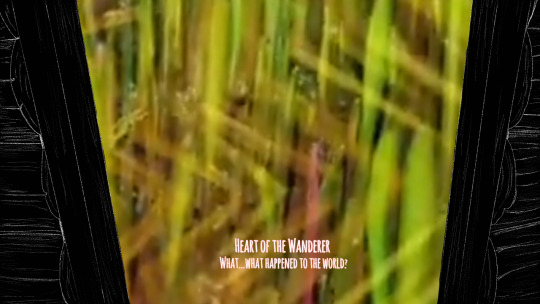
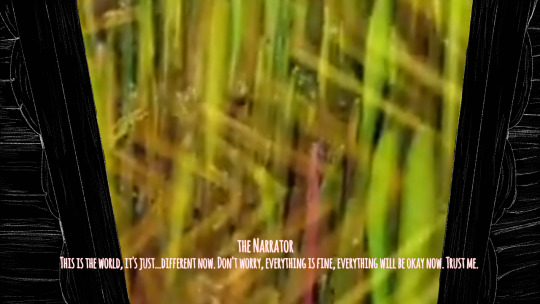
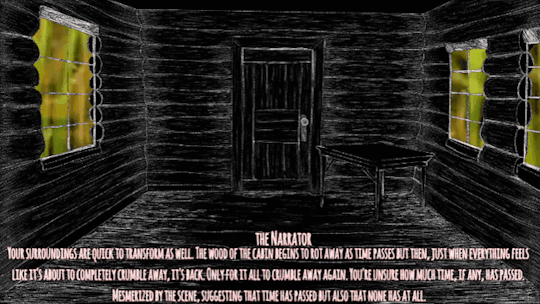
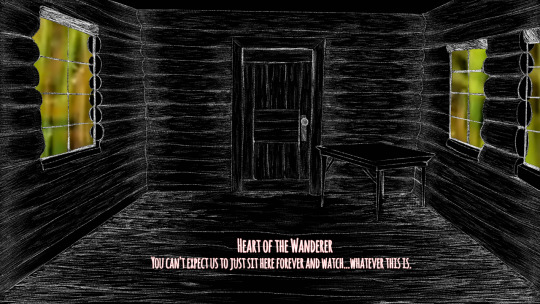
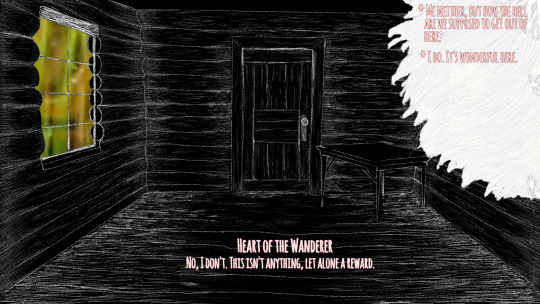
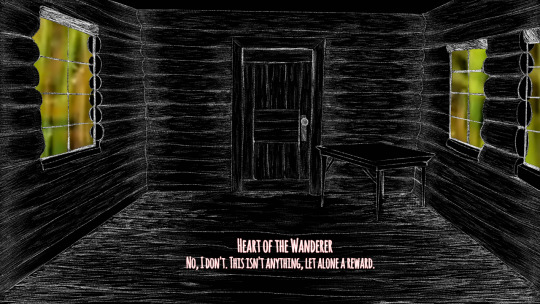
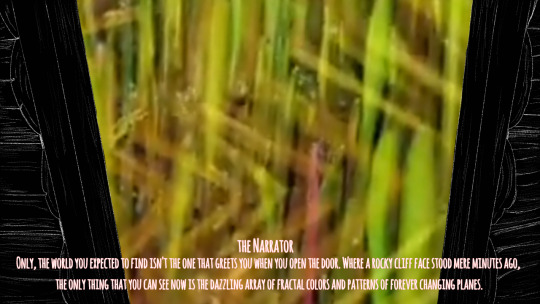
Transcript:
The Narrator: Only, the world you expected to find isn't the one that greets you when you open the door. Where a rocky cliff face stood mere minutes ago, the only thing that you can see now is the dazzling array of fractal colors and patterns of forever changing planes.
Heart of the Wanderer: What…what happened to the world?
The Narrator: This is the world, it's just…different now. Don't worry, everything is fine, everything will be okay now. Trust me.
The Narrator: Your surroundings are quick to transform as well. The wood of the cabin begins to rot away as time passes but then, just when everything feels like it's about to completely crumble away, it's back. Only for it all to crumble away again. You're unsure how much time, if any, has passed. Mesmerized by the scene, suggesting that time has passed but also that none has at all.
Heart of the Wanderer: You can't expect us to just sit here forever and watch…whatever this is.
The Narrator: ‘This’ is your reward for saving everyone. …..Don't you like it?
Heart of the Wanderer: No, I don't. This isn't anything, let alone a reward.
Choice text:
* Me neither, but how the hell are we supposed to get out of here?
* I do. It's wonderful here.
#tumblr plays slay the monster#slay the monster#chapter i: the wanderer and the monster#slay the princess#stp au#choose your own adventure
52 notes
·
View notes
Note
WOW THAT ANIMATION IS AWESOME!!!!
And sky islands theme is such a bop hell yeah!
How did you do the ascii art karma part??? Did you run normal digital art through a custom shader? I'm hella curious, it looked badass as FUCK. I would like an insufferable amount of details, if you don't mind!
Thank you! That part was done with code in Processing that I wrote to create karma pixel art from a normal image/image sequence. It works on any image, but is better with low-detail hyper-saturated ones:

The source code is here on Github. I've organized the files so that as long as you have Processing 4 downloaded, it should run out of the box.
The function karmaPixelSequenceFromImage takes in an image and spits out a png sequence, which I fed into ImageMagick to get the above gif. A modified version of that code is what I used for the animation.
The function genKarmaArray essentially creates a 2D array of randomly-picked karma symbols and assigns each a color based on a corresponding point in the original image. The function createTextScreen renders a 2D array of karma symbols into a png. Calling genKarmaArray and createTextScreen each frame gets you the same image, but with different karma symbols each time.
Part of me wants to convert the code directly to P5.js and create an interactive version that can be accessed directly online. Then everyone would be able to create their own gifs. I may not have the time though.
The processing-misc repository linked above is what I used for the majority of my animation. For most scenes I would export png sequences from Procreate to Processing, and after putting the pngs together with code in Processing, I would export the result to DaVinci Resolve. The load.pde file has a lot of the functions I used to display specific frames of an image sequence in Processing, which I would combine with Processing-drawn fractals, etc. I may share more of the .pde files I used if others are interested.
A combination of load.pde and karmaText.pde is what I used to create that part of the animation. I drew the originals in Procreate, applied the "filter" in Processing, and used the resulting png files to Resolve.
Original version of the above:
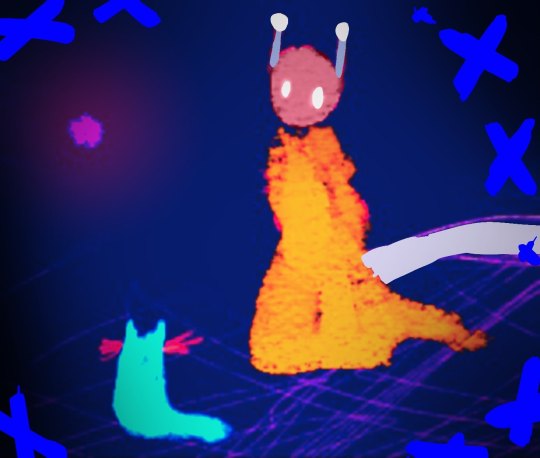
23 notes
·
View notes
Text
#starscream#transformers#this poll fic crashed tumblr twice i hope you all know my sacrifice#i am so brave
37 notes
·
View notes
Text
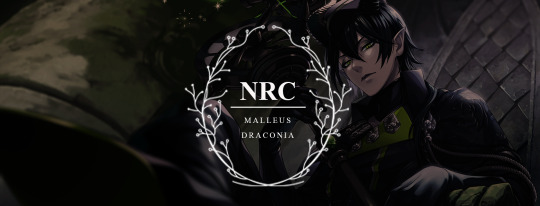
Fractal
Inc: Malleus, Prefect. WC: 2k Warnings: Dream horror, consumption of rotten fruit, everything seems happy but there's an underlying layer of 'somethings rotten in denmark (briar valley)' Excerpt: “Nothing.” You reply steadily. “I just haven’t been here before.” Liar. Malleus remains still for a moment before he laughs, and you hate how warm the sound is as the sun comes out once more. “Well of course you have not been here. That is why I chose this place—I wanted to show my friends my home.”
It’s you who causes the cataclysm this time.
He’s in a field that’s warm, and for once the sun—which beats down on him from a baby blue sky—does not give him a migraine, nor does it make his skin itch with the ghostly sensation of hives. He’s sitting at the end of a long dining table with a white tablecloth concealing its mahogany structure. It’s adorned with an array of foods; fruits, vegetables, meats—a cornucopia of delights to dig one's fingers into. It’s what he anticipates happening upon the arrival of his guests, who will fill the twenty-two empty wooden chairs that are present.
His gaze remains focused on the far end of the field, where a gap in the trees that create a barrier around where he sits is present. He remains still, motionless, as though he’s a wind up doll waiting for someone to turn his key. The sounds of cicadas screaming from the distant pines and the warm wind that brushes across his pale skin do little to stir him out of this strange state. He hardly even blinks. He merely sits and waits.
Until you appear at that gap.
Then, like that key turning, everything comes to life. He takes a breath in and sits up, a smile curling on his thin lips as his hands come to rest on that pristine, white tablecloth. He remains still as he watches you approach. Your steps are shaky, and you seem tired as you take your time to reach where he sits, as though every step is a labour for you to complete. When you finally reach the other end of the table, you draw to a stop, your gaze transfixed on the feast before you. Perhaps you are looking at the meat, or perhaps you are looking at the flies that are beginning to garnish its surface.
“You got my invitation.” Malleus’ voice is warm, as though he’s attempting to project a certain image of himself to you. You glance towards where he sits. He looks composed, regal, in the plain wooden chair with the sun creating a halo behind his head. He gazes back at you, and it feels like those green eyes are slowly peeling away each layer of flesh, parting each tendon and muscle, until he can see the white of your bone beneath. You swallow.
“I did.” Your voice is quiet as you resist the urge to look back at the gap in the trees. Three more pairs of eyes watch you from within the shadows as you try to walk your way through these steps. You’ve done this before. Many times before. “It was kind of you to invite me.”
His smile remains as he doesn’t reply for a moment before gesturing to the seat—the one next to him. “Sit, Prefect. You look tired.”
You move slowly around the table until you reach the seat to which he is gesturing. When you pull it out, it rips up the earth beneath it, causing the scent of dirt to mix with that of decay. He pushes a glass filled with a clear liquid towards you and you dutifully take it, although you refrain from raising it to your lips. He drinks unashamedly and without care.
“Am I early?” You ask, selecting each piece of dialogue in your mind with caution. You watch as he finishes drinking, setting the empty glass down as he does. His lips are stained slightly red from the action and his tongue darts out to clean them, slowly running along the bottom one as his gaze goes back your way.
“Yes, but that is of little concern. I have no objections to being in your company a moment longer,” he muses, sharp white teeth flashing as he observes you with amusement. “The others should be arriving soon.”
Malleus looks back to the gap in the trees as you study his profile. The skin beneath his eyes looks slightly bruised up and along his cheekbones—the area where his overblot patterning is. His hair is brushed back from his forehead, revealing the scales beneath, and his expression is fixed into one of childish excitement. He wears white, but the edges of his sleeves are stained. “They all received an invitation. I made sure of it. I am not apt to forget my friends, unlike some.”
“Perhaps they got lost.” You murmur, looking at that gap in the trees yourself as you do. You can see movement within the shadows as you continue to buy your time. The scent of decay grows until you’re eventually forced to look back to the feast. Wrinkled fruit, greenish meat, drooping herbs, and liquidated vegetables; the sight makes your stomach curl as you keep speaking. “After all, this place is unusual.”
“Unusual?” Malleus’ head turns to look back at you, his eyes still too wide, his expression too exuberant. “What is so unusual about it, Prefect?”
You feel your breath catch in your chest as you stare back. The movements by the gap have stopped as well, as though the entire scene has been paused with your single comment. You can hear the rustle of that warm wind through the corn field behind you, and the sun is soon covered by a passing cloud. You clench your hands in your lap.
“Nothing.” You reply steadily. “I just haven’t been here before.”
Liar.
Malleus remains still for a moment before he laughs, and you hate how warm the sound is as the sun comes out once more. “Well of course you have not been here. That is why I chose this place—I wanted to show my friends my home.”
The tension dissipates at that moment as Malleus picks up a few figs from the table. He sets them on his plate and presses a fork into one. You try to ignore how squishy it is, or the green that oozes from its inside. “Wouldn’t it have been better if we had dinner at your palace?”
He doesn’t reply as he spears one piece of rotten fig with his fork, turning it over slowly before holding it out to you. His smile still doesn’t dissipate. “No. I do not think it would have been. I want my friends to feel connected to one another. I want them to feel like a family.”
You glance at the fig piece. It sags on the metal prongs, making your stomach twist in disgust. There’s expectation in Malleus’ eyes that conceal a glint of something else—a test. So far you have been selecting the right reactions, but it isn’t sufficient.
You lean forward, keeping your gaze locked on his as you take the fig piece in your mouth. You’re trying hard not to gag as you chew slowly before forcing it down your throat. There’s a lingering after-taste of rot present and you finally grab at the water glass.
He chuckles and leans back before picking up another piece for himself. “I admit, it’s a bit sour, but tolerable all the same.”
Sour? It’s rotten, but you refrain from saying this aloud as you drink. You said it aloud before, and the results went as poor as they could go. There’s only so many times you and the others can formulate a plan before it becomes apparent that it’s all for naught. Eventually you set your glass down with a grimace and watch as it immediately refills itself. It’s magic, obviously—Malleus has been throwing his magic around unashamedly and without care. The soil nurtures him, the sun gives him life, the winds carry his words. He is both the creation and the creator of the feast you sit at. The executioner, and perhaps the sacrifice as well.
Or maybe that role is solely for you. After all, you are the one he is feeding right now.
You tilt your wrist slightly to catch a glance at the watch you wear around it. Phones and technology are pointless here—not that you have your phone anyway—so Lilia gave you this as a manual means. The hands are not moving, and instead remain fixed at five to five. You are still in a dream.
“Are you impatient?” His voice causes you to drop your wrist quickly and look his way. It’s hard to mask the surprise on your face. In fact, it’s quite pointless. That razor sharp gaze that peeled away your skin when you first approached now cuts incisions into your skull as he tilts his head, studying you. “They have five minutes.”
Five minutes will never come. You’re not sure if Malleus even knows this. It’s as though he’s settled himself so deeply into this dream he’s created—a tick, gorging itself on the magic of its own making, unaware of how its body swells and strains until the point that it bursts from over-consumption. He’s becoming inflated with his power. It’s how his overblot has not ended, despite the way he hides it with glamour.
“Are you sure you invited them?” You ask cautiously again, testing the waters. You see a twitch in his smile—the corner of his thin lip wavering slightly. His eyes remain wide.
“Yes. I wrote the invites myself. Everyone got one—Lilia, Silver, Sebek, you. Those of Heartslabyul, of Savanaclaw, of Octavinelle, of all the rest. I considered those from RSA, but I would rather keep the peace for this event.” His hold tightens around the fork. You can see the threads fraying. You push.
“Are you sure the invites were received? Did anyone tell you they would come?” You murmur, leaning a bit closer. You hate doing this—this is someone you consider your friend, perhaps more in another life, and you are not an orchestrator of someone's mental fracture. The cicada’s stop screaming. Another cloud passes over the sun.
“You never RSVP.” He replies, his voice now more monotone and colder. His smile remains but his eyes have slid back to the emptiness you’ve been seeing since his overblot began. He looks to you once more, and you scramble to see some remnant of the peculiar prince you’ve come to know in those eyes. “And yet you came.”
“I’ll always come,” you reply quietly, the scent of rot growing stronger with each word. You see movement in your peripheral vision again. The sky darkens further, and the wind begins to grow cold. “Whether you mean it or not, I’ll always come. But I cannot say the same for everyone else. Sometimes people don’t arrive, or they leave without goodbyes. Sometimes—”
His expression twists. It’s like a child hearing something they don’t want to hear, or when they’re denied a toy they want so badly to be theirs. His body stiffens and his upper lip curls. “Stop it, Prefect.”
His voice is low, dangerous. You’re pushing it again, just like all the other times so far. You see another figure approaching the table. Someone with silver hair, someone who looks as though they’ve aged many years in mere moments. They hold a weapon at their side. Your own hand darts out and grabs Malleus’ arm. Despite the demeanour, despite the rage, his arm is solid and warm beneath your grip.
“Malleus,” you begin, desperation starting to lace in your voice. You see a flash of green and hear the clattering of something hitting the table, and then he jerks his arm away. You feel the crushing sense of overwhelming power before with a snap of his fingers he’s in a field that’s warm, and for once the sun—which beats down on him from a baby blue sky—does not give him a migraine, nor does it make his skin itch with the ghostly sensation of hives. He’s sitting at the end of a long dining table with a white tablecloth concealing its mahogany structure. It’s adorned with an array of foods; fruits, vegetables, meats; a cornucopia of delights to dig one's fingers into.
It’s what he anticipates happening upon the arrival of his guests, who will fill the twenty-two empty wooden chairs that are present.
#malleus draconia#twst malleus#twst#did u know i avidly write dream horror in an interactive game i make?#twst x reader#anyway someone drag me from this malleus fic hell plz :/
111 notes
·
View notes
Text

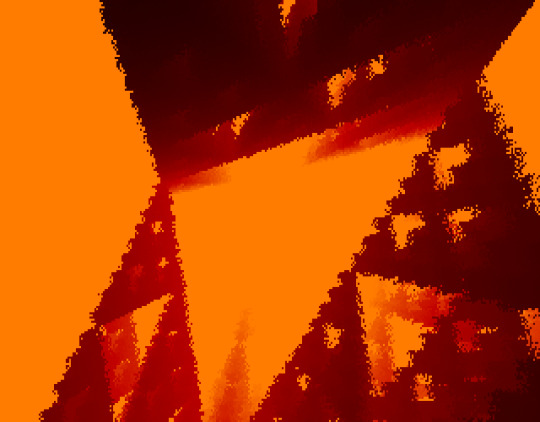
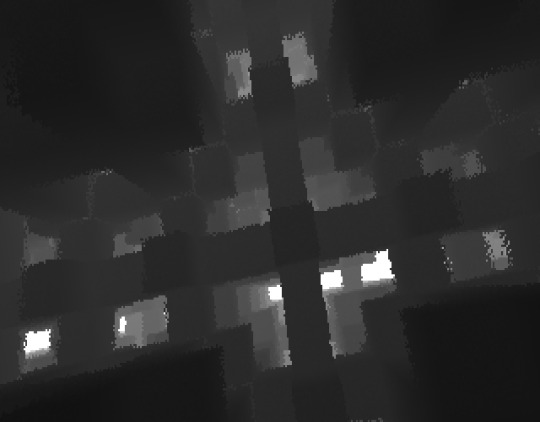
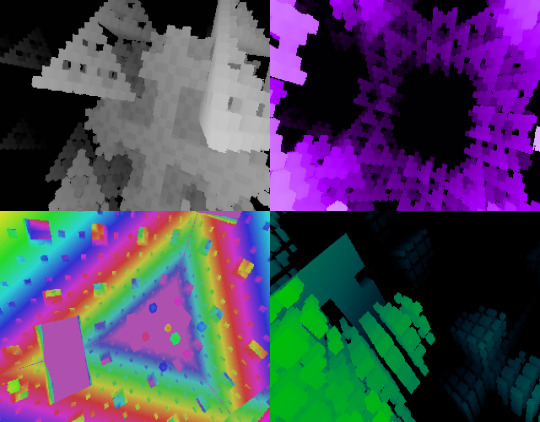
Hi I saw a demo by Héll Mood and wanted to try coding it on javascript myself :3>
It's kinda slow (bruteforce-raymarching-over-a-3D-array slow) but it's fun to explore randomly generated sierpinski-like sponge fractals.💮 Move with arrow keys, hold shift to go faster.
Credit where credit's due, this was made by closely trying to visually replicate the original demo Atlantis, by Héll Mood.
I learned a lot about ray marching, math, algebra, fractals, and some crazy bs about javascript. Weak typing is chaotic, can't believe the best way to force integer division is to use double bitwise not operator like ~~(a/2)
Anyway hope you like!
#demoscene#fractal#programming#menger sponge#javascript#intro#html#ray marching#algorithm#raytracing#sierpinski sponge#js#was debating if i should post this on main or on my side blog but whatever#to my main it goes
36 notes
·
View notes
Text

'With its nigh-impenetrable defenses and stems and leaves armed with razor-sharp silica spines edible only to the most specialized and hardiest of herbivores, the saberleaf grass has become one of the most widespread and successful flora on HP-02017. Found across most continents, this well-defended plant has become quite diverse over the eons, some becoming short, stocky sabershrubs, and others, in certain parts of Gestaltia where tall plants are otherwise scarce, grow into the towering sabertrees, forming lethal forests that accommodate only the most adapted and defended wildlife. Yet, due to its abundance, saberleaf too has become a practically-limitless resource to those that had evolved to exploit it. Most obvious are the ungulopes, whose constant grazing prevents saberleaf from crowding out other species of plants: yet, on a smaller scale, other creatures have found ways to take advantage of the saberleaf's overkill defenses to benefit their own survival.
The saberleaf gallwasp (Spiculoformator scorpiocauda) is a small species of parasitic wasp that, while descending from ancestors that once parasitized other insects, now has adapted to parasitize plants: using their long, sharp and retractable ovipositors to deposit an egg, one at a time, into the tissues of plant hosts: specifically, saberleaf hosts. The insertion of the egg triggers the surrounding plant tissues to form a sort of botanical tumor that surrounds and encloses the egg: on the outside forming a fractal array of snowflake-like silica spines radiating from a hard external shell, yet inside, becomes full of soft, pulpy tissue that makes an ideal nursery for the developing wasp larva, serving as both food and shelter for it. Safe inside the gall, the larva is well-protected from predators and parasites alike, and even ungulopes--otherwise specialized saberleaf eaters-- can suffer painful mouth injuries when they ingest the galls on accident.'
-------------
#speculative evolution#speculative biology#spec evo#speculative zoology#hamster's paradise#art one shot
80 notes
·
View notes
Text
Brute Force Adventure Writing?
I’ve found success lately by writing my 1D6 tables as 1D8 tables, then cutting the two least interesting options. Even if I write just one extra option and make a cut, it tends to make a stronger encounter table. A 1D4 table? Write five options, review and cut the most boring or repetitive one. Write lots, keep what’s best. Is this brute force adventure writing? Or like just, normal editing? I don’t know. I’m not a professional. But it works.
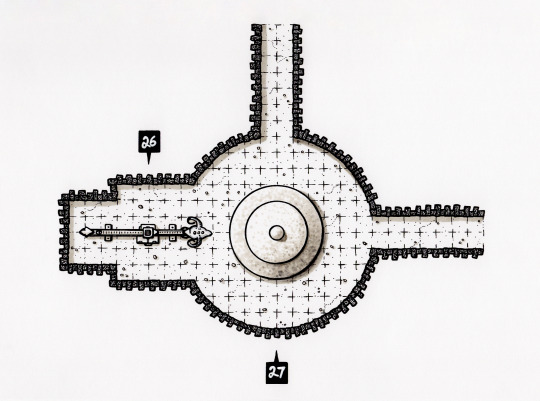
In one of my latest dungeon rooms, players can encounter a giant urn full of nanomachines. The Nanites can combine into several forms. I went for a 1D4 table in this case, wrote five options, then cut one.
Nanomachine Gestalts
1. Statuesque Humanoid: From a distance, the swarm appears human. Tall and graceful, gleaming with reflected light. Up close, the figure takes on an alien appearance, its proportions exaggerated, its face grotesque.
2. Kaleidoscopic Lattice: Arrays of Nanomachines chain together, rapidly filling the room with a complex matrix of crushing fractals. Passage through the area becomes increasingly dangerous.
3. Electric Amoeba: An amorphous shape, its iridescent volume warps and quivers in all directions. Appendages appear and disappear as it blindly probes the room.
4. Monolithic Geometry: Cubes and other angular shapes form a mass of intersecting surfaces, reflecting the world around it. New structures erupt like animated pyrite, extending to unexplored passageways, while trailing offshoots reconstitute into the primary locus.
5. Simulacrum: The Nanomachines appear as a cloud of iridescent dust. Several are inhaled by a member of the adventure party, entering their bloodstream and brain. The remaining Nanites will fill the room, creating a space based on the adventurer’s memory, for all to see.
I ended up cutting #3 from the available options. It was too similar to option #4 in form and function. Plus I wanted to push the “machine” aspect in nanomachine. Really, #3 inspired me to write #4 – a classic blob monster, but more mechanical? Of course. Giving the encounter a more organic bent could have been interesting? But I thought the humanoid form in option #1 filled that niche well enough. Given every other option, #3 didn’t have a lot going for it. Overall, I think the table is stronger without it.
And I just want to say…
Why’s it gotta be so hot? I’m so unproductive in the summer. Any amount of heat seems to sap my motivation. So, a perfect time of year to wrap up a mega-dungeon. And yet, progress has been made. I just cracked 200 pages on my latest project, The Electric Triptych of the Tetric Necromancer. By the end of next month I should have all 12 (out of 12) areas laid out and edited. After that, I’ll want to draft an introduction, a timeline of events, a few adventure hooks and such, but the entire dungeon will be playable from start to finish. That’s something.
Stay cool, people.
#ttrpg#dungeon23#ttrpg maps#dnd#indie ttrpg#ttrpgs#osr#drawing#ttrpg art#inkdrawing#writing#creative writing
16 notes
·
View notes
Note
i generally don’t believe that penny will come back again, but i did realize that if she came back again it would have a sort of parallelism to salem, if she were to become immortal via ascension or some other means. specifically given your reading that the GoL killed salem before dropping her in the pool. thoughts?
if it happens, ambrosius did it
given what was laid out thematically in V9, i don’t think there’s any path for penny to return as penny. she died. anything that takes the choice of what her next life will be away from her is wrong, both light’s afterlife (eternal stasis) and being rebuilt by her friends/family.
but i think it’s quite likely that a) remnant’s afterlife is some form of reincarnation cycle with the pattern having been set by salem’s deaths and resurrections in the divine pools, and b) as discussed in the linked post, what they asked ambrosius to do with penny bent the rules so far that his power was partially freed. (note oddities like him lingering out of the staff after time started moving again and penny’s robot body disintegrating after he made the portals even though it explicitly should not have been destroyed at all because he only assembled it.)
thus, the possibility that penny may be subject to special circumstances based on ambrosius having recreated ascension with his own magic.
the interesting piece for penny is that she was not designed to have agency. the atlesian military built a soldier, a weapon, and gave her a soul because—presumably—ironwood wanted to explore the feasibility of transferring the maiden powers into robotic soldiers as a solution to various Problems. penny was not supposed to be a person and, of course, her personhood was only tolerated to the extent that she followed orders and the entire atlas military pivoted away from defending atlas from salem to forcing penny to submit and obey the instant penny failed to fall in line. it is also made clear in V8 that penny’s friends/family also impinge on her agency in ways that make her really quite unhappy, mainly out of overprotectiveness.
so, if this character has been plugged into a sort of bootleg ascension—what does it look like for her to, as ambrosius put it, “come to the surface” after her death?
human!penny represented what her friends wanted for her, and the whole ordeal is by turns bittersweet and horrific; the death of penny’s robotic body is downright gruesome because it is framed strictly from penny’s point of view, and in the subsequent fight there are multiple beats showing that penny has lost important pieces of herself (floating array, her tactical software). and of course penny has never once expressed feeling an actual problem with being a robot.
at the same time, though, her robotic nature did leave her uniquely vulnerable to certain forms of compulsion (watts’ virus, pietro’s remote control) and intensified the dehumanization she experienced in the atlas military. so i think penny likely had complicated feelings.
in the end, every choice she could have made was systematically stripped away from her until the only thing she had left was who to hold in her final thoughts; weiss, or winter. the pragmatic choice or her best friend.
she chose her friend.
if penny then found herself in a place where the only thing that can happen to her is what she wants, what does she choose? who does she become? penny is dead, but her essence lives on. (there’s a possible rhyme here with “salem lives, but the woman you hold dear in your memories is gone”—the god of light has nothing but disdain and malice for salem, and she has not changed in the way he implies, but it is true that she isn’t the same girl ozma knew millions of years ago.)
the other factor is that fractally, penny is repeating ozma, and both the virus and the remote control are metaphors for his parasitic reincarnation so she is thematically connected to ozma’s immortality in an overt way. so in the event she returns during the run of the show i imagine it would be in some form that answers ozma’s curse, i.e., as a new person without her memories a la ascension and definitely not as a voice in [winter’s/ruby’s] head as is the common set of theories.
but i also tend to think that if it happens it’ll be an epilogue thing—after the war is over—because penny was built to be a soldier in that war and the last choice she made before she died was defiant of that purpose. it makes sense to me that she would return to a time of (genuine) peace.
32 notes
·
View notes
Text
Tealeaf surreptitiously slid his hand across the table and tentatively laid it over Caleb’s own. In a flash, their gaze met. King felt Caleb’s hand flinch and fall still, just the faintest pulse of tension thrumming beneath the skin like an electric current. A sharp intake of breath caught in his throat, but Caleb made no move to pull away.
Kingsley squeezed Caleb’s hand and let the pressure ground him, holding on until his breathing evened out. This close, King can see every neat line of scarring deliberately scored into his deathly pale skin, crawling up his arms and still eating away at him. Weaving vines of ivy choking out the life from him. Hands the chalky white of crumbling marble, of ancient statues and abandoned temples—sacred, desecrated—cracks splintering and breaking. Caleb bows his head. A faithless man moved to prayer.
Confession and penance at the temple can be costly, depending on the god you aim to please. But Kingsley isn’t so demanding, and his readings are only five copper a piece.
Real salvation runs steep. Caleb’s body lying still at Lucien’s feet, Jester crying when her spell strikes true, fractured memories twisting into nightmares. Fractals and fractals of a pattern spinning into dozens more. Nine eyes. Nine butterflies. Death and rebirth. The cycle endlessly repeats.
Lucien got a taste of godhood, a peek into something beyond, a little glimpse behind the curtain—and sometimes, Tealeaf's soul still feels chained and bound, everything too muted, ancient ache of a phantom limb. This world is more, it’s supposed to be more, and he was connected to it once, all of it, and now he’s permanently cut off. Always chasing that rush. Nothing could compare to the high of godhood.
Ichor tastes sweeter than ale. Bleeds prettier than blood.
Ale. Right. They’re drinking, some shitty ale at some shitty tavern, him and—
“Caleb,” King chokes out. Reminds himself. Runs his forked tongue over teeth, raps his claws on the table and just tries to fucking think.
Looks down at the scars again. Caleb…
He wore bandages before, Kingsley knows. Kept them covered up in dirty old rags yellowing with age, singed and charring at the edges. Mollymauk was no stranger to wounds left to fester; he ached to take Caleb by the hand and delicately unwrap each filthy bandage, peel all the layers away and scrub his skin clean, wash and lather him with lavender scented soaps, gentle touches dancing on his skin. He wants to soothe and treat all the pain carved into him.
“I know you’ve had a run of bad luck,” King says.
Caleb’s roaring laughter makes him choke on the watered down tavern ale, sputtering until he’s nearly crying.
“That would be an understatement,” he chuckles, still shaking his head in wry disbelief. “Luck is…generous, Mr. Tealeaf. It implies the fault was not my own.”
Caleb’s voice is always a little muted. Breathy. Wrung ragged by a bone deep weariness that claws at his throat in a hoarse rasp. Silken smooth when he’s laying all his cards on the table in a coldly calculated gamble. Skewing a tad gruff and husky when he’s caged and cornered and lashing out, despondently desperate. A little rugged and rough around the edges, bleeding raw. Attractive--that's dangerous.
Kingsley could fall asleep to the sweet lull of that voice.
“You are staring, Tealeaf,” Caleb admonishes.
King can’t hide his creeping grin. “Can you blame me? You’re pretty to look at."
His nimble fingers fiddle with the cards again, shuffling them with a deft hand. He knows each one by heart, as surely as the lifeline of his own palm--and the matching array of gruesome scars.
When King feels the warm touch of a familiar kiss upon his brow, soft and comforting--for a moment, he's whole and radiant again. Blessed and divine.
#widomauk#had some of this lying around for a while so i am putting it here--#head full. many soft circus man and magic man thoughts--
14 notes
·
View notes
Text

"DMT-EDMT Series for December Geometry #29"
Previous Posts (1-28):
The Butterfly Fractal 1 (BF1) is a fractal resulting from the simple doubling of quantity "1." -- as shown in the TOP animated gif image. 1 -- 1x2=2 -- 1x2x2=4. -- 1x2x2x2=8,...
When you lay it out into its "Butterfly-like" array, you can see that every "1" becomes a new source for the self-similar, re-iterative redundancy of the same "fractal" pattern within -- as shown in the LEFT still image.
The TOP Header of the Divisor Matrix Table (DMT) is the same BF1 sequence -- 1--2--4--8... (It is also the Header of the EDMT to be shown later.)
The entire DMT -- and its sibling tables -- are ALL based on simple multiples of the BF1 sequence!
The DMT gives us ALL of the natural whole numbers, and, ALL of their Divisors! Quite a deal for such a simple geometric arrangement of such simple parts.
They both give us the Mersenne Prime - Perfect Number pairings and the 10 parameters that identify each Mp-PN! And they are ALL related (connected)!
And get this! They do so in a completely "fractal-like" manner in the template form that defines them. Each fills out the template the same way -- only with their own starting values -- and each has values that inform the starting values of the "next" and the "next-next" and the "next-next-next"... Sometimes the values are direct -- other times the result of the Running Sums (∑) of the direct values as the fractal expands.
Talk about ENTANGLEMENT! Well, it has to start somewhere! Seems like the beginning is a good place!
Today's post:
Perfect Number (PN) 8128 is shown as the Butterfly Fractal 1 (BF1) image above. It is itself composed of 127=z=Mp units of the fractal BF1=1--2--4--8--16--32--64 where 64=x, as PN=xz=64•127=8128. That's 8128 quantity "1's" laid out in the template BF1 pattern of each doubling of the previous "1" total as is shown on the next level up, as it was for the other PN "containers" that came before, and collectively inform this Butterfly Fractal 1 (BF1) image:
PN6=1--2 on the Left Wing & 1--2 on the Right Wing = 3+3=6
PN28=1--2--4, 1--2--4 + 1--2--4, 1--2--4 = 14+14=28
PN120 ("container"-only)=1--2--4--8 eight times 15 = 15+15+15+15+15+15+15+15=8•15=xy=PN=120
PN496=1--2--4--8--16 = 16 times 31=xz=PN=496
PN2016 ("container"-only)=1--2--4--8--16--32 = 32 times 63=xz=PN=2016
PN8128=1--2--4--8--16--32--64 = 64 times 127=xz=PN=8128
as each PN container starts building its BF1 template pattern on the ending "1's" of the previous PN. Notice that the z=Mp=Mersenne Prime "container" value arises as the Running Sum (∑) of the respective BF1 for each level, i.e. 3--7--15--31--63--127...
The add-on structural form that arises as more and more of the expanding BF1 is added is entangled from the get-go. Whatever the actual "content"-value of quantity "1" is, defines throughout what this Butterfly Fractal 1 (BF1), indeed, stands for! It may go from the extreme abstraction of quantity "1"= the concept of a single mathematical expression of any given quantity "1," to the expression of so much Space per so much Time (ST), to the integral expression of charge (+1, -1), ... you know, everything!
more...
#rbrooksdesign#digital art#fractals#butterfly fractal 1#entanglement#quantum entanglement#exponentials#primes#mersenne prime squares#perfect numbers#number theory#mathematics#geometry#divisor matrix table#dmt#math#graphics#archives#bim#entropy
44 notes
·
View notes
Text
Cathedral Eyes
I view my life
through stained glass glasses-
Kaleidoscopic assemblage
augments my vision,
fractal arrays of
color punctuated with
perpendicular black lines.
I peer through the
rose hue,
but not just!
My sadness becomes
chartreuse, my anger
morphs to violet.
Technicolor on the mind-
distant dissonant shades
are easier to
give my attention
than the creeping
greyscale in my peripherals.
I’m told to take
off the glasses is to
act my age,
but how could
I act anything besides
the years in my possession?
If I could lend
you my sight,
you might see
black and white shades
are more saturated
than you ever imagined.
#original poem#poem#poems and quotes#poetry#poems and poetry#creative writing#writeblr#original poetry#original writing#poem and poetry#spilled ink#spilled in poetry#spilled in words#spilled in writing
3 notes
·
View notes